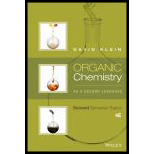
Concept explainers
And now, for a challenging problem, try to draw the mechanism of a desulfonation reaction (a reaction where we take the SO3H group off of the ring). The process will be exactly the reverse of what you just drew in the previous problem. There will be three steps: (1) remove the proton from the SO3H group, (2) H+ comes on the ring, and then (3) SO3 comes off of the ring. The truth is that there are only two core steps here: H+ comes on the ring, and then SO3 comes off of the ring. You can actually pull the proton off of the SO3H group at the same time that SO3 comes off of the ring. Try to do it yourself, and if you get stuck, you can look at the answer in the back of the book. Make sure that your mechanism involves an intermediate sigma complex (with a resonance-stabilized positive charge).
Want to see the full answer?
Check out a sample textbook solution
Chapter 4 Solutions
Organic Chemistry As a Second Language: Second Semester Topics
Additional Science Textbook Solutions
General Chemistry: Principles and Modern Applications (11th Edition)
Chemistry: The Central Science (13th Edition)
Chemistry: An Introduction to General, Organic, and Biological Chemistry (13th Edition)
Chemistry & Chemical Reactivity
Chemistry: A Molecular Approach
Fundamentals of Heat and Mass Transfer
- Construct an efficient three-step synthesis of 1,2-epoxycyclopentane from bromocyclopentane by dragging the appropriate formulas into the bins. Note that each bin will hold only one item, and not all of the given reagents or structures will be used.arrow_forwardFor the third step of the first reaction why is there a ch2-ch3 group connected to the epoxide, shouldn't there just be a ch3 group connected to it?arrow_forwardWhy doesn't this reaction proceed and how could it be changed so that it is successful?arrow_forward
- In the box to the left of each reaction below, write the mechanism by which it occurs (could be SN1, SN2, or E1, or even 2 of them). Then draw the product(s).arrow_forwardWould someone be able to draw the full mechanisms for these two reactions? Are these E1 or E2?arrow_forwardComplete the reactions below, write the type of mechanism (S1, S2, E2).arrow_forward
- Several reagents and several organic structures are shown below. Construct a multistep synthetic route from the reactant 2-methyl-1-butene to the product 3-bromo-2-methyl-2-butanol by dragging the appropriate pieces into the bins. Note that each bin will hold only one item, and not every given reagent or structure will be used.arrow_forwardThe following reaction is slow and gives an unusual product. Propose a mechanism for the observed product based on what you know about SN1 and SN2-type mechanisms.arrow_forwardshow the missing reagents and intermediates in the reaction sequence belowarrow_forward
- Draw the product for the substitution reactions below. Then, draw the proper FULL electron-pushing mechanism for the reaction, including intermediates with lone pairs and formal charges, and all electron pushing arrows (SN1 vs SN2). Label the electrophile and nucleophile in each step.arrow_forwardI do not understand the first two. I have not seen the reactants used in Q2 before, and for Q1 I thought it would result in elimination.arrow_forwardComplete the reactions given below, write down the type of mechanism (SN1, SN2, E1, E2)?arrow_forward

 Organic Chemistry: A Guided InquiryChemistryISBN:9780618974122Author:Andrei StraumanisPublisher:Cengage Learning
Organic Chemistry: A Guided InquiryChemistryISBN:9780618974122Author:Andrei StraumanisPublisher:Cengage Learning

